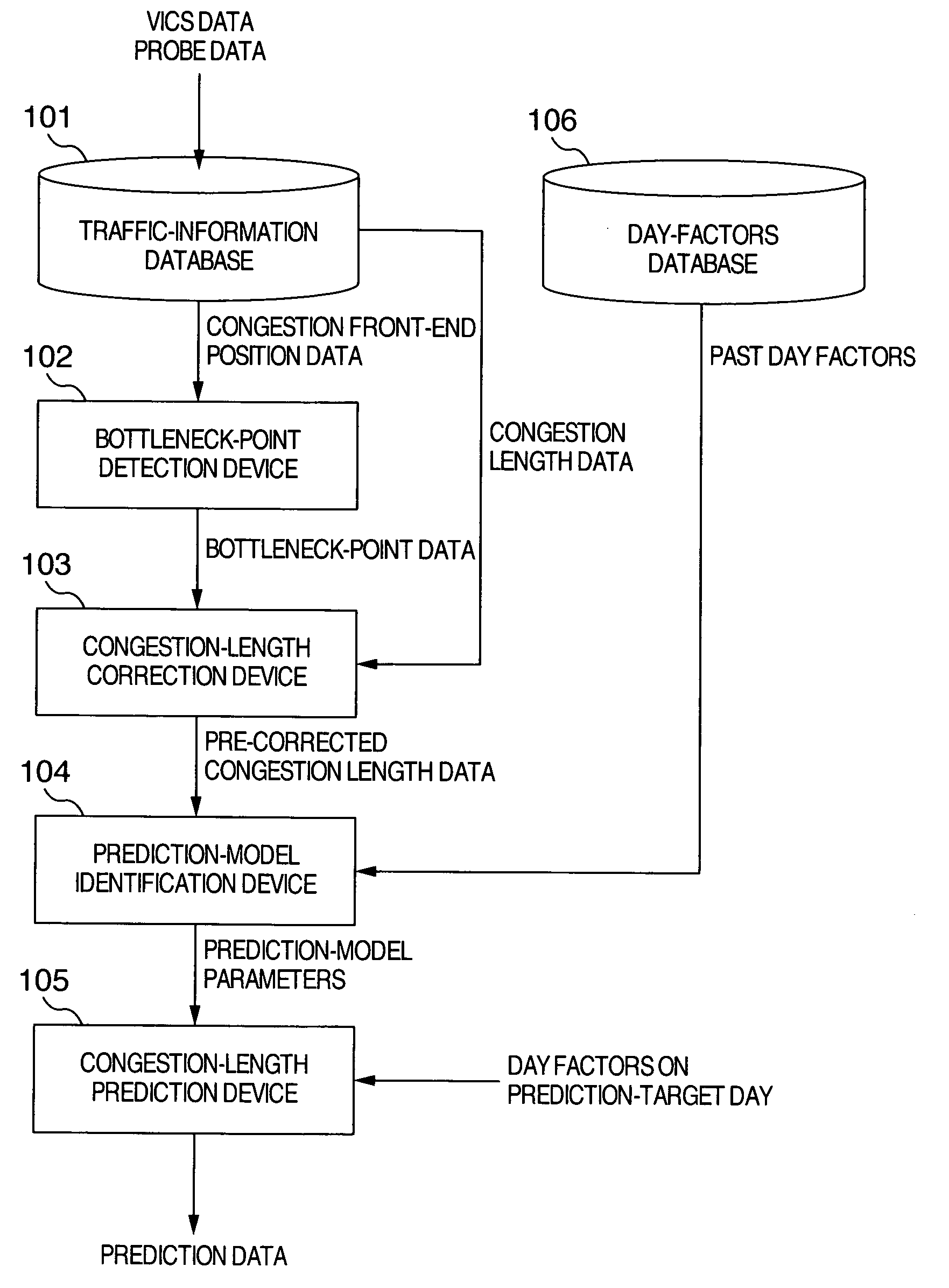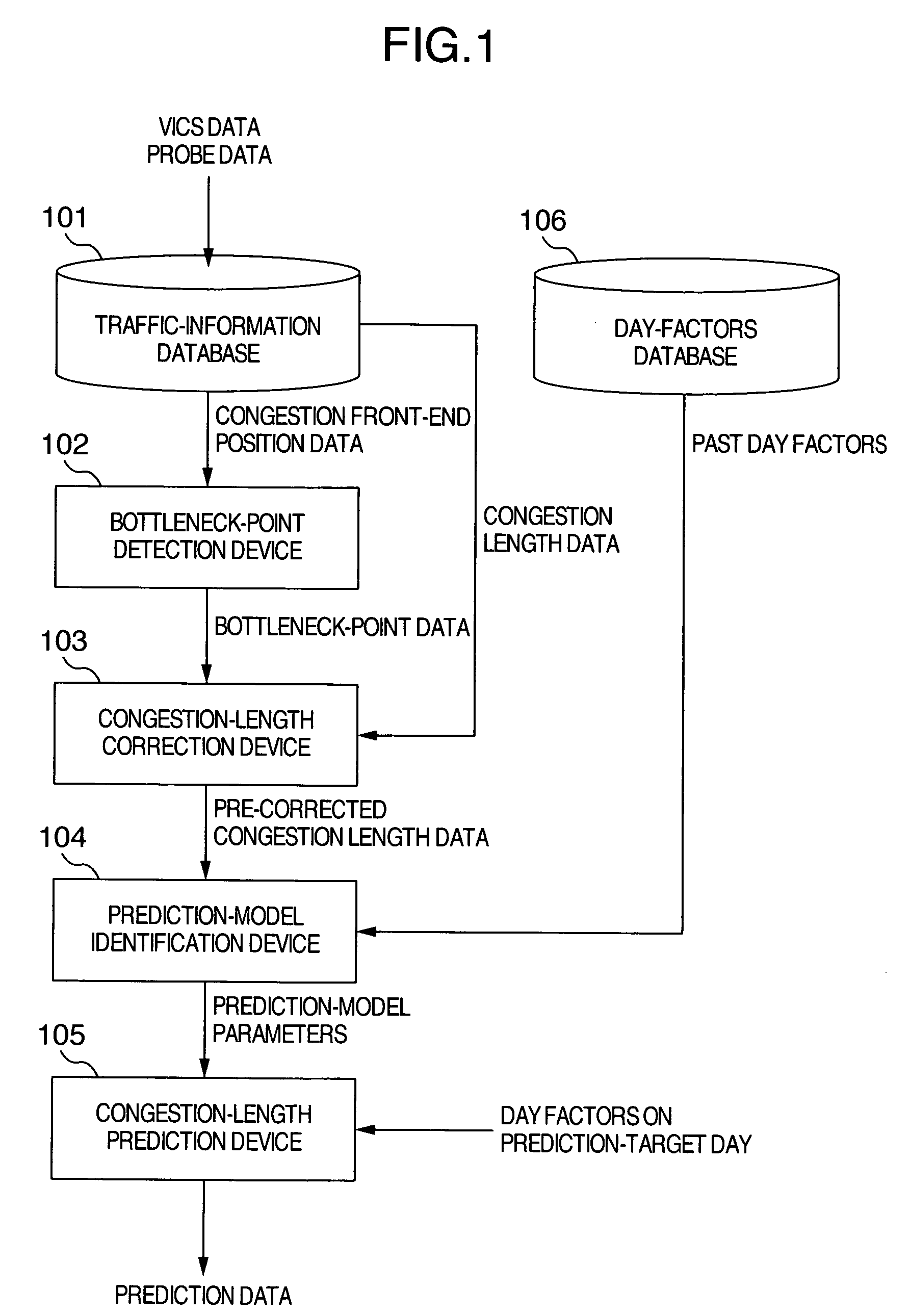Traffic information prediction system
a technology of traffic information and prediction system, applied in the field of traffic information prediction, can solve the problems of congestion, inability to perform statistical processing in the conventional technology,
- Summary
- Abstract
- Description
- Claims
- Application Information
AI Technical Summary
Benefits of technology
Problems solved by technology
Method used
Image
Examples
embodiment 1
[0025]FIG. 1 illustrates configuration of a congestion-length prediction device where the present invention is used. A traffic-information database 101 is a database device for accumulating past traffic information collected by a mobile unit equipped with a sensor such as a VICS (: Vehicle Information and Communication System) or a probe car. A bottleneck-point detection device 102 performs detection of bottleneck points by the clustering. In this clustering, from the past congestion front-end position data on each link basis accumulated in the traffic-information database 101, the data existing in a spatially closer range on one and the same road link are summarized, then being assumed to be a continuous data range. FIG. 2 illustrates a flow diagram of this processing. A processing step 201 (which, hereinafter, will be described as “S201”. The other processing steps will also be described similarly.) is initialization of clusters. Here, as indicated in (a) in FIG. 3, each of the co...
embodiment 2
[0030]FIG. 5 illustrates configuration of a system for predicting traffic-information data in accordance with the following method: Namely, in the congestion-length prediction device where the present invention is used, instead of performing the regression analysis on each point-in-time basis like the first embodiment, the congestion length data on a day-unit basis is approximately represented by a linear summation of plural pieces of basis data which are the type of data that represent rush hours in the morning or evening. Then, the regression analysis in which the day factors are defined as the independent variables is performed with respect to each summation intensity of each basis data. This allows identification of a regression model and execution of the prediction operation using the regression model in a feature space whose dimension is lowered as compared with the original congestion length data.
[0031] In this embodiment, using the principal component analysis, a basis-data...
embodiment 3
[0039] Instead of including the basis data on each link basis like the second embodiment, representative basis data are prepared in a mesh unit which is a spatial region including plural links. This makes it possible to tremendously reduce the data amount of the basis data to be recorded into the prediction database 505. As the representative basis data on each mesh basis, however, it is impossible to use statistically representative value such as same point-in-time average value of the basis data on each link basis acquired in the second embodiment. The reason for this is as follows: In the process of calculating the same point-in-time average value from the basis data on each link basis, components specific to the traffic-information data of each link are lost. As a result, it becomes impossible to represent the traffic-information data of each link by a linear summation of the representative basis data. Accordingly, in the congestion-length prediction device where the present inv...
PUM
 Login to View More
Login to View More Abstract
Description
Claims
Application Information
 Login to View More
Login to View More - R&D
- Intellectual Property
- Life Sciences
- Materials
- Tech Scout
- Unparalleled Data Quality
- Higher Quality Content
- 60% Fewer Hallucinations
Browse by: Latest US Patents, China's latest patents, Technical Efficacy Thesaurus, Application Domain, Technology Topic, Popular Technical Reports.
© 2025 PatSnap. All rights reserved.Legal|Privacy policy|Modern Slavery Act Transparency Statement|Sitemap|About US| Contact US: help@patsnap.com



